The History Of Renault Logan
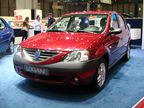
The Logan is a no-frills car produced jointly by the French manufacturer Renault and its subsidiary Dacia of Romania. It is manufactured at Dacia's automobile plant in Mioveni, Romania, in Colombia, Brazil and many other sites. Whether the car is marketed as Dacia, Nissan or Renault in a country depends on the existing presence of the Renault brand in it.
The Logan was the end result of Project X90, announced by Renault in 1999 after the buyout of Dacia in 1998. During a visit to Russia by French President Jacques Chirac, Louis Schweitzer noted that at Lada and Renault dealerships the €6,000 Ladas were selling very well, while the €12,000 Renaults stayed in the showroom. "Seeing those antiquated cars, I found it unacceptable that technical progress should stop you making a good car for €6,000." (He later revised this target to €5,000). "I also drew up a list of specifications in three words – modern, reliable and affordable – and added that everything else was negotiable."[citation needed] However, the cheapest version of the car is priced at almost €6,000, and can reach €8,500, depending on equipment and customs duty (the base model for Western Europe, where it is badged as a Dacia but generally sold in Renault dealerships, is somewhat more expensive). As it was designed from the outset as an affordable car, the Logan has many simplified features to keep costs low.
The car replaces many older cars in production, including the Romanian Dacia 1310 series of Renault 12-based cars.
It was officially launched in 2004. Renault originally had no plans to sell Logan in Western Europe, but began importing a more expensive version of the car in June 2005, starting at around €7,000. It became an unexpected success with people wanting an inexpensive, no frills car they could repair themselves. The Logan was launched in India in June 2007 as a collaboration with Mahindra, who helped Renault cut costs by 15%. India was the first right hand drive market for the Logan. It was almost an instant success with impressive sales in the first few months and is the best-selling car in its class.
A facelifted version was announced on the 1st of July 2008 called the New Logan.
The Logan is based on the B platform that is used by the third generation Renault Clio, Renault Modus and the latest version of the Nissan Micra. It has 50% fewer parts than a high-end Renault vehicle and has a limited number of electronic devices. In addition to making the car less costly to produce, this also makes it easier and cheaper to repair. As with many low-cost vehicles, a large amount of soundproofing was omitted, meaning that road vibrations, engine sound and wind noise are noticeable for the passengers.
Some parts are also much simpler than those of its competitors. For example, rear-view mirrors are symmetrical and can be used on either sides of the car, the windshield is flatter than usual, and the dashboard is a single injection-molded piece.
The developers have taken into account several differences between road and climate conditions in developed and developing countries. The Logan suspension is soft and strong, and the chassis sits visibly higher than most other superminis to help it negotiate dirt roads and potholes on ill-maintained asphalt roads. The engine is specially prepared to handle lower quality fuel, whereas the air conditioning is powerful enough to lower temperature several degrees (above 40°C are common in the Middle East and Mediterranean Sea).
Safety
In June 2005 the car achieved a 3 star rating at the EuroNCAP crash tests. This result confirms initial expectations stated earlier by Renault.
Engines
In markets where Renault has an existing presence, such as European, African and Asian countries (i.e. Romania, France, Italy, Belgium, Netherlands, Germany, Greece, Hungary, Poland, Czech Republic, Croatia, Slovenia, Morocco, Lebanon, Syria, Turkey and many others) it is sold as the Dacia Logan. Exceptions are Argentina, Russia, China, Colombia, Egypt, Brazil, Chile (Colombian made), and Venezuela where it is marketed as the Renault Logan. The Logan is vital to increasing sales of the Renault group to the 4 million mark by 2010. In India, the Logan is marketed as the Mahindra Renault Logan; Renault partnering with the Indian utility and commercial vehicles manufacturer Mahindra & Mahindra Limited. In Mexico, the Logan is sold as the Nissan Aprio, given the better reputation of the Japanese brand in the Mexican market..
In 2007, Iran also began selling Logan models by Renault-Pars Co. manufactured in Pars Khodro and Iran Khodro . After a mere month of production, more than 100,000 Tondar-90, as it's called there, have been ordered, even though deliveries will start only in May 2007 .
Dacia have plans to produce CKD versions for assembly in various target markets.
Since the beginning of production in 2004 and up to the end of 2006, a total of 321,284 Dacia Logans were sold..
Dacia sales for 2006 were over €1.5 billion, 19.6% up in comparison with 2005. Annual production have almost reached 250,000 cars, half for exports.
Production began with a 4-door sedan, followed by a wagon in September 2006. Four other models, including a pickup truck, a hatchback and a new sedan version followed in 2007 and 2008.
Logan MCV
The Logan MCV (Multi Convivial Vehicle), launched at the 2006 Paris Motor Show, is the station wagon version of the Logan . It has five or seven seat versions, with a luggage space that varies between 200 and 2350 litres depending on how many seats are folded, as well as numerous storage spaces for smaller objects.
It uses the same engines as the sedan version . An important improvement is the availability of side airbags. Sales began in October 2006 on the Romanian market with prices ranging between €8200 and €11600. , and was extended to other countries in early 2007. A revised version, with the new lights and bumper from the Logan saloon, was released in late 2008.
Logan VAN
The business version of the Logan was launched on January 23, 2007 in Bucharest . It is a small business oriented vehicle, with 2500 litre loading space and 800 kg payload. The Logan VAN is more or less an MCV without the rear side windows and therefore has the same safety features and uses the same engines as the other models (except the 1.6 16v engine). Sales have started in Romania, with prices ranging between €6700 and €8800.
Logan Pickup
The pickup version of the Logan, also based on the MCV, was introduced on September 10, 2007 . Sales have begun in Romania in 2008 with prices ranging between €7250 and €8350. In October 2008 the Logan Pickup will be sold in South Africa as a Nissan NP200. Visually it resembles a mildly facelifted Logan bakkie and it is being built in South Africa alongside the Renault Sandero.
Sandero
Main article: Dacia SanderoThe Sandero, a five door hatch based on the Logan, is to be launched for the South American market. Compared to the 4-door saloon, it has a smaller wheelbase; it is built in Brazil, and sold there under the Renault brand from December 2007, being exported for other countries as well (In Colombia will be built and its expected to reach the market on August 2008). A version of the Sandero was launched in Europe on June 3, 2008, it is built in Romania, badged as a Dacia vehicle.
Logan Steppe
In 2006, a station wagon concept car, the Dacia Logan Steppe was presented at the Salon International de l'Auto in Geneva. The car was built by noted concept car builders DC Design in India as a forerunner of the Logan MCV.
Logan S2000
The S2000 was a short lived project for a racing version of the Logan ,.
- Dacia Logan S2000 Test
From Wikipedia, the free encyclopedia
More About Renault Logan
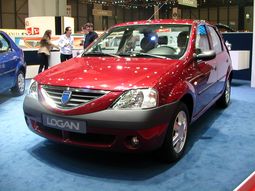
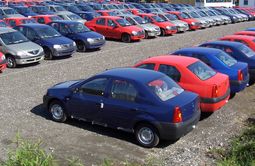
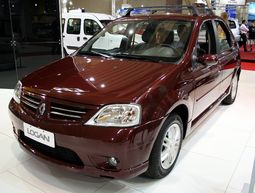

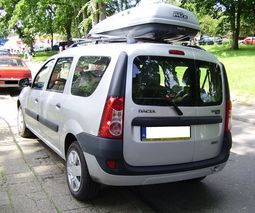

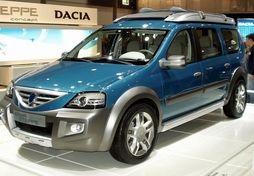
|